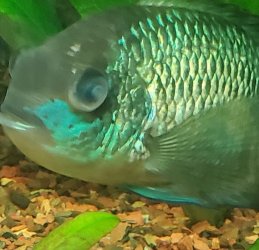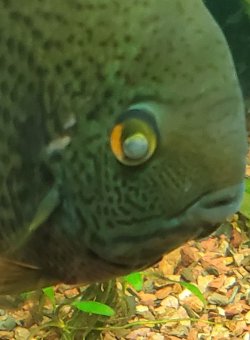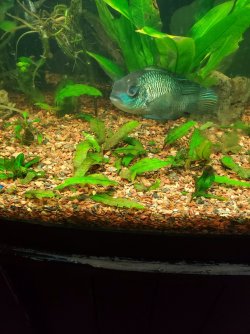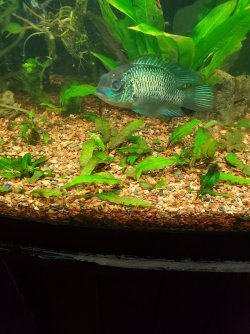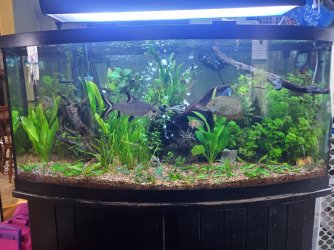TheRisingPhoenix
New Member
Hello everyone,
I am new to this forum but not at all new to fish forums in general. I am an experienced freshwater tropical (mostly SA Cichlids) fish and reptile enthusiast. I am having issues in my 72 bowfront planted South American Cichlid community. I dose DIY Co2 (Citric acid/Baking soda) and I'm currently running a Sunsun 304b with UV sterilizer built in addition to a powerful air machine and wave maker(powerhead essentially). I thought I had enough oxygen in the water column to help combat the amounts of Co2 being injected into the tank. So I noticed my Turquoise Severum had a white cloudy growth on his right eye. I thought initially it was injury but then my Electric Blue Acara had same growth on left eye. I thought both got onto a fight and gave each other an injury until my a Cory catfish started to die. I tested the water parameters and the ph was below 6.0 and the test didn't read of course bc 6.0 is lowest readable. I use liquid api master test kit. My ammonia was ever so slightly spiked at 0.5 to 1.0. My Nitrites are normal and Nitrates are normal around 5/10 ppm. I bought a digital ph water tester and the ph is at 5.2 way too low. My thought is the growth is bacterial due to waste build up bc the beneficial bacteria can't maintain the load bc of the very low ph. So i raised ph with a water change and the baking soda method. After a few days I am at 6.8 ph and all other test results are exactly the same. Even the ammonia. I am also dosing the tank with melafix to help heal the bacterial infected eyes. They seem to be doing a little better but im still worried and wondering if I diagnosed correctly. Im turning to forums for secondary advice. Any advice is welcomed and appreciated. All other fish in my tank are fine. I've since moved the remaining Cory catfish to a Q-tank and dosing melafix in there as well. They seem to be doing better also. Thanks in advance.
I am new to this forum but not at all new to fish forums in general. I am an experienced freshwater tropical (mostly SA Cichlids) fish and reptile enthusiast. I am having issues in my 72 bowfront planted South American Cichlid community. I dose DIY Co2 (Citric acid/Baking soda) and I'm currently running a Sunsun 304b with UV sterilizer built in addition to a powerful air machine and wave maker(powerhead essentially). I thought I had enough oxygen in the water column to help combat the amounts of Co2 being injected into the tank. So I noticed my Turquoise Severum had a white cloudy growth on his right eye. I thought initially it was injury but then my Electric Blue Acara had same growth on left eye. I thought both got onto a fight and gave each other an injury until my a Cory catfish started to die. I tested the water parameters and the ph was below 6.0 and the test didn't read of course bc 6.0 is lowest readable. I use liquid api master test kit. My ammonia was ever so slightly spiked at 0.5 to 1.0. My Nitrites are normal and Nitrates are normal around 5/10 ppm. I bought a digital ph water tester and the ph is at 5.2 way too low. My thought is the growth is bacterial due to waste build up bc the beneficial bacteria can't maintain the load bc of the very low ph. So i raised ph with a water change and the baking soda method. After a few days I am at 6.8 ph and all other test results are exactly the same. Even the ammonia. I am also dosing the tank with melafix to help heal the bacterial infected eyes. They seem to be doing a little better but im still worried and wondering if I diagnosed correctly. Im turning to forums for secondary advice. Any advice is welcomed and appreciated. All other fish in my tank are fine. I've since moved the remaining Cory catfish to a Q-tank and dosing melafix in there as well. They seem to be doing better also. Thanks in advance.


